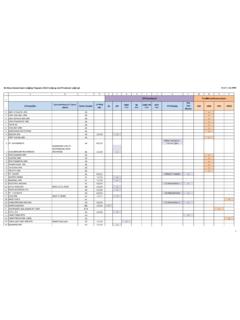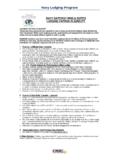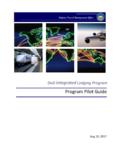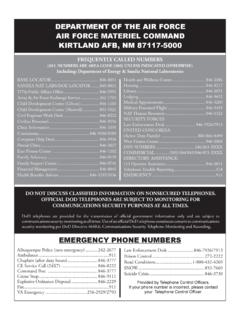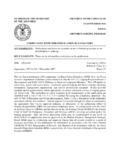Transcription of Chapter 2 MWR/Services Categories and Funding - …
1 Chapter 2 MWR/Services Categories and Funding Soldiers (and sailors, airmen, marines and coast guard) are entitled to the same quality of life as is afforded the society they are pledged to defend. (US Army MWR) MWR/Services History MWR started on the battlefields of World War I, where behind the lines, Salvation Army sisters and Red Cross volunteers ministered to the needs of soldiers as the forerunners of today s MWR specialists. After World War I was over, Funding stopped and morale programs were mothballed. It wasn t until July 1940 that the Morale Division later named Special services was established within the Army s Adjutant General s office.
2 Similar organizations were established in the other services . Between 1946 and 1955, the core recreation programs were established and staffed by a combination of active duty military and civilians. Until the mid-1980s, active duty enlisted members and officers held occupational specialties in Special services and club systems and were assigned at every level of command. As these occupational specialties were discontinued, civilians continued to operate MWR programs with military oversight. Special services underwent much reorganization and had many names before coming to its present configuration as Morale, Welfare, and Recreation ( MWR/Services ).
3 NOTE: The US Coast Guard refers to the W in MWR as Well-being. The US Air Force refers to the broader term, services , which includes MWR programs. The Marine Corps refers to the broader term, Marine Corps Community services , which includes MWR programs. Purpose of MWR/Services The purpose of MWR/Services is to establish programs that maintain mission readiness and retention. These programs promote fitness and esprit de corps of members of the Armed Forces, a strong sense of military community, and beneficial quality of life for authorized patrons. Authorized patrons include, but is not limited to, active duty military personnel, reserves, retirees, DoD/CG civilian employees, DoD/CG contract personnel working on an installation, and their families.
4 All five services , working through the Office of the Secretary of Defense (OSD), have developed and maintain an accepted prioritized listing of eligible patrons for their MWR/Services programs. Programs, based on the assessed needs of local patrons, accomplish these specific objectives: Support military readiness through physical fitness. Support needs for camaraderie and unit cohesion. Support individual growth and development. Support family well-being and quality of life. Provide the military installation community with access to these programs.
5 These programs are similar to those available in a comparable civilian community, and are perceived as a valued benefit of being part of the military. They are considered part of the military s non-pay compensation benefits. MWR/Services Funding Morale, Welfare, and Recreation is part of the installation commander s responsibility. In addition, the installation commander is required to manage all of the resources of the installation. MWR programs are funded through a complex mix of appropriated funds (APF) and non-appropriated funds (NAF). YOU need to know the Categories of activities and how they should be funded because YOU are the expert on whom the installation commander will rely to manage Funding effectively.
6 Appropriated Funds (APF) are, by definition, those funds that are appropriated by Congress. In other words, APF represents money in the US Treasury. Nonappropriated funds (NAF) are real dollars generated from sales and participation fees from MWR/Services programs and activities. NAF are: Not from Congress Earned at installations Used for collective benefit Separate from US Treasury In general, nonappropriated fund instrumentalities (NAFIs) are required to be largely self-supporting in order to survive. The basic standard, regardless of category, is to use APF s to fund 100% of costs for which they are authorized.
7 In the past, more of the Funding for MWR/Services was through appropriated funds, making it easier to show a net profit. In today s constrained fiscal environment, that support is diminishing; financial management is a more critical management skill than ever before. MWR Programs and Descriptions, as outlined in DoDI , Enclosure 5, 6 July 2009 and Coast Guard Morale, Well-Being, and Recreation Manual, CMSTINST (series) 1. CATEGORY A MISSION SUSTAINING PROGRAMS. These programs are considered essential in meeting the organizational objectives of the Military services .
8 They promote the physical and mental well-being of the military member, a requirement that supports accomplishment of the basic military mission. They shall be supported almost entirely with APF, with the use of NAF limited to specific instances where APF support is prohibited by law or where the use of NAF is essential for the operation of a facility or program. Programs in this category have virtually no capacity for the generation of NAF revenues. a. Armed Forces Entertainment. Acquisition and support of professional entertainment provided free to Military Service members overseas.
9 B. Motion Pictures Provided at No Cost to the User. Free motion picture entertainment, licensed for public viewing, provided to shipboard sites, isolated areas, and deployed military personnel regardless of format. c. Physical Fitness. Programs that develop the components of aerobic capacity, muscular strength, muscular endurance, and flexibility, in conjunction with body fat measurement, that are within an optimal range for military personnel. d. Aquatic Training. Includes swimming programs associated with Service member training. Does not include those recreational swimming programs in Category B or aquatics centers in Category C.
10 E. Libraries and Information services Program. Supports readiness and the military mission, QOL, voluntary education, professional and technical education and training, Internet access, lifelong learning, transition and career assistance, and the leisure needs of military communities. f. On-Installation Parks and Picnic Areas. Provide on-installation picnic areas, barbecues, pavilions, game fields, fitness trails, nature centers, playgrounds, etc., for self-directed use. g. Basic Social Recreation Programs. Provide directed and self-directed individual and group activities that promote stress relief such as social networks, video games, entertainment videos, board games ( , chess), social events, and Internet access.
